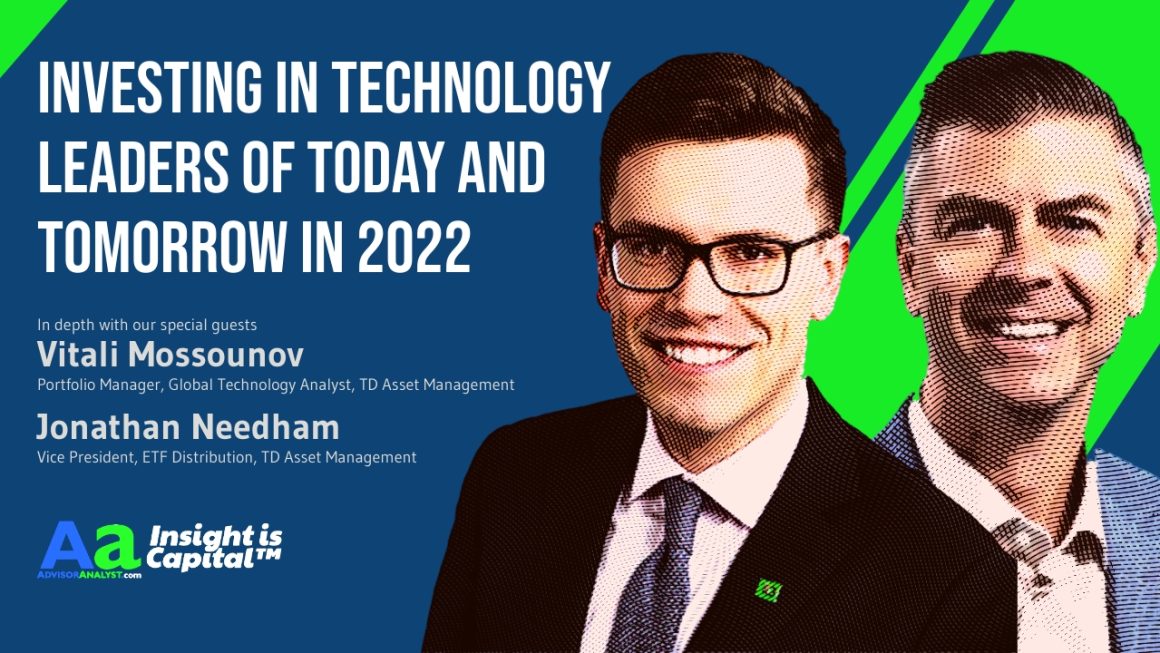[00:00:00] Pierre Daillie: Technology stocks have gotten off to a rough start this year, while some mega cap technology names have fallen modestly, many others have lost a third or more of their values since the new year. Overall, the NASDAQ 100 is down roughly 19.5% year to date. The S&P 500 is down by about 11.5% year to date in 2022. But in the midst of all of the noise of today’s uncertainty and volatility, if you go back and take another look at the gigantic financial performance numbers of some of the mega cap names that reported earnings for the final months of 2021, it’s really hard to understand why this isn’t an inflection point that could be a key moment for investors to increase their allocations to what will still be the fastest growing segment of the market and the economy.
Joining me to talk about the tech sector is TD Asset Management’s Vitali Mossounov, Global Technology Analyst and Portfolio Manager of the TD Global Technology Leaders Index ETF, Canada’s largest technology ETF, Ticker TEC. And the TD Global Technology Innovators ETF, Ticker TECI.
Jonathan Needham, Vice President of ETF Distribution at TD Asset Management joins us as well.
[00:01:15] Disclaimer/Announcement: This is the Insight is Capital Podcast.
The views and opinions expressed in this podcast are those the individual guests and do not necessarily reflect the official policy or position of advisor, analysts.com or of our guests. This broadcast is meant to be for informational purposes only. Nothing discussed in this broadcast is intended to be considered as advice.
[00:01:33] Pierre Daillie: Vitali, Jonathan, welcome. It’s great to have you both for this very timely conversation.
Yeah. Thanks, Pierre great to be here.
I think to start things off, it would be great if you would tell us a little bit about your backgrounds and your positions at TD Asset Management.
Sure.
[00:01:49] Jonathan Needham: Yeah. Thanks. Thanks. Pierre yeah, long story short, I’ve been, in the, investment management business for over two decades now, servicing advisors across this country for various asset management firms. So been with TD for over two years now, as you said, I’m VP, of ETF distribution here. So focus on building our franchise, and getting TD Asset Management’s name out in the marketplace.
yeah, 20 plus years servicing advisors, MBA, licensed PM. I had a, brief stop at a FinTech firm, before joining TD and previously was head of marketing and head of distribution for a very large, asset manager also with an emphasis on exchange traded funds.
[00:02:30] Pierre Daillie: Wonderful. Vitali?
[00:02:31] Vitali Mossounov: Only half of that, unfortunately half of that experience, I’ve been in the industry for a decade, but, before that, I actually started out as an accountant. And, I was an auditor for a while and I enjoyed it quite a bit, but I realized, you learn a lot of rigour, but you’re always looking at, [stuff], information, things that are already on the books. So I thought that forecasting the future and studying businesses was, far more exciting.
And, made the switch, first to the broker dealer side and then to the investment management side. So right now my, day to day is really to wake up and, look at, technology companies, figuring out what the trends are and, what the individual businesses are up to. And, we’re ultimately predicting their future free cash flows and valuing these, these companies.
[00:03:20] Pierre Daillie: I imagine your, background as an accountant, helps you to determine also the fundamentals or the quality of the fundamentals for a lot of these businesses as well.
[00:03:49] Pierre Daillie: Absolutely. vitali, let’s jump in. What’s your take on how tech stocks have performed so far this
year?
[00:03:57] Vitali Mossounov: My take c- can only look objectively, looking at the facts, as you mentioned earlier, they haven’t performed very well at all. Now, what do I think about that? I think the market’s full of ups and downs, any price action on the course of, daily, weekly, or even monthly is, pretty much unpredictable. And I don’t necessarily have it, have that data sending me into any panic or frenzy. at the end of the day, we know that the, price of, companies, the businesses will converge on the value of those companies, meaning the present value of their future free cash flows.
And, that’s, where we focus our time. So the real question, and the, a negative answer to which would have me concerned is how were these businesses doing? And we’ve just gotten through the earning season and, that w- that’s, that, that wasn’t your question, but I-
[00:04:51] Pierre Daillie: I’m getting to that.
[00:04:52] Vitali Mossounov: I’m not that worried.
[00:04:52] Pierre Daillie: Yeah, so basically in a nutshell, technology stocks are down, but, I, think we should get to the heart of the, the, questions that sort of surround why they’re down. A lot of the chatter in the market points to the inflationary impulse that we’re seeing right now, the rising rates, the duration of the earnings of tech companies, as seen as a cause of the pullbacks, when we’re talking about things like discounted cash flows.
But it seems like in a lot of, cases, the baby was thrown out with the bath water. We’ve seen a lot of, big pullbacks in, in companies, in some cases that were surprising. What are your thoughts on the argument that rising rates are to blame?
[00:05:34] Vitali Mossounov: No, I, there’s something to it, but I, will say investors are a funny bunch. I think when, stocks are going up, they’ll find reasons to buy the stocks. And when stocks are going down, they’ll find reasons to sell. And then, after they’ll come and say, I did X because of Y, right? But that’s not really WHY they were doing it in the moment. And long duration stocks were getting bid up, throughout the pandemic, because they were, because the interest rates were low? I don’t think so.
I think a lot of these businesses accelerated their fundamentals, investors liked what they saw, their investors saw what other investors were doing and, they followed suit. And I think a lot of that is unwinding today. Now, a lot of investors, again, they’re looking around and saying oil’s, hitting, God knows what number these days. Those companies that produce oil and sell oil are gonna be doing pretty well.
The banks might benefit with higher interest rates. So I think that this, long duration argument, becomes convenient to rationalize something so complex that, in the moment we never do know what, it is that we’re doing and why. But at the end of the day, again, that is a part of the market, as you said, the, big tech companies and the kind of free cash flows that they produce and the valuations they trade out, something that, not a risk that they’re subject to anymore than the typical company, the S&P 500.
[00:06:55] Pierre Daillie: So you, you wouldn’t point to, there being lots to worry about on the fundamental side, right? we’re talking about a, reaction to financial conditions rather than, a reaction to fundamental conditions for the sector.
[00:07:10] Vitali Mossounov: Exactly. and financial conditions matter. ultimately, if, there is going to be a savings account at a large financial institution that pays 10% interest, that’s going to affect the allocation decision for investors, whether they want to buy now a stock with the 2% dividend yield, the relative attractive, attractives of that. So I don’t want to sound, dismissive of financial conditions. They are, relevant and we can see which way the wind is blowing now.
But it, if anything, it’s just to emphasize that if we think that the world continues to exist within certain boundaries, right? Whether that’s, interest rates between X and Y or inflation between A and B over, over a multiyear horizon, then, I don’t think the narrative is broken at all. And for those of your listeners that might say, I, don’t believe that. I think, oil’s going to a $1,000 a barrel, go- gold’s going to $10,000 a barrel. I said, you should stop listening to this ’cause you’re not going to benefit from it very much, there’s a better use of your time.
[00:08:22] Pierre Daillie: Yeah. as an aside, if you look at, companies like Amazon, Apple, Google, Microsoft, which is the, household names, mainstays, the four, four American companies that are now worth an excess of, trillions of dollars. Like it’s remarkable when you look for example, Microsoft is above two trillion, Apple, nearly three trillion, in that ballpark, those companies reported enviable growth in 2021.
even Facebook’s disappointing earnings were, relative. The stock got, punished a little bit more, but, when you look at even what was supposed to be terrible at Facebook, the company’s profits grew by 35% in 2021 down from 60% growth in 2020. In terms of fundamentals, it’s, it’s not that terrible. it’s, it’s one of those things that, that sort of befuddles, I think the market, which is that these companies have these blockbuster profit margins, blockbuster revenues, blockbuster earnings, and of course, they’ve had the market caps too, to, go along with that. But fundamentally, are these businesses in any danger of cratering anytime soon?
[00:09:40] Vitali Mossounov: And that’s our job to watch that. And, I think the answer, to that is no. the world, the world is quite dynamic these days, to put it lightly. And so that’s, that’s always a worry, but a ultimately, if you think about, to distill it down to, simplest terms, you, have companies that have the loyalty and affinity of billions of users, that pay these companies significant sums of money in order for products that make very large contributions to their daily lives. Yeah.
Take the iPhone for example, where we are examining that risk of a collapse as you put it is, is there going to be a competitive technology platform or a product that risks undermining that relationship that Apple has with customers? You don’t think that’s a risk for years to come? And then secondly, could there be a large regulatory shift? I can’t tell what we’ve seen in, China with their tech giants that changes the social contract, if you will, between these companies, society and the government that undermines their economics.
And I think the beauty of the, Western system is as much as it’s upheaval in, in recent years, but we do have the relative stability of our institutions and the predictability of, their actions as far as these economics go and the tax rates and so on. So I’m feeling pretty good, I would say from, those perspectives up there.
Yeah. I, don’t want to, you mentioned Apple, but I, and I did too. You don’t wanna, I don’t wanna gonna single out any one particular company, but when you look at the scale of their growth, it’s, staggering. Apple’s revenue grew by more than $90 billion in 2021, about a third more than 2020. and that’s, probably owing to COVID to some degree, but, that was also despite a global shortage of computer chips.
And likewise with Amazon, you look at Amazon, sales in 2021 were 67% larger in 2019, the year before the pandemic. And Google’s revenue was nearly 60% greater than in 2019. So it’s, no surprise, I think, to anybody that these companies did well, in that, in the context of the pandemic. But what they showed was that there was capacity among all of us to use these services and products a lot more.
Is there any thought at all that we’ve had a couple of years of blockbuster growth because of the closing trade, and now that things are reopening, some, folks are under the impression that’s going to subside?
It’s an important question. and, there’s no clear answer, I would say, about the level of benefit or, frankly detriment that these businesses saw for the pandemic. I would say the short answer to your question is they weren’t obvious pandemic beneficiaries and expectations that a big chunk of Amazon’s revenue is about to go away. that would be correct.
[00:13:00] Pierre Daillie: Yeah.
[00:13:01] Vitali Mossounov: Ultimately, you, listed out some of those enormous growth rates. Ultimately, we are sensitive to the fact that things our business is operating in the real economy, and somebody used pay the money for them to, continue to grow. And the scale that they’ve reached does not make it easy. And so it would be a problem, I would say, a big problem if we were looking at the likes of Apple and Google, and they were asking us to pay 50, 60, 70 times earnings for these businesses, because we would have trouble justifying, enough market space for them to grow into this.
But I think that these present valuations, the majority of those businesses, aren’t demanding, and extraordinary amount of faith. the, pandemic, it has come, hopefully it has now gone. You’ll see, in any given quarter, a company report a little bit of an impact that maybe investors didn’t expect, maybe they benefited on this line item, and maybe they have been suffering another one, Someone like a Google, probably making somewhat less money maybe because of, traveling. So people did advertise, might not have had a, an online travel agent, putting ads on Google last year, but that was made out by maybe a mobile game, developer that wanted to get, kids playing when they’re stuck at home. So there’s a lot of moving parts here, but ultimately, again, these companies are so large and so well diversified across the broader economy, that, the, pandemic narrative is not what’s gonna move the needle here going forward.
No, and, likewise, there’s so many businesses that are ancillary to some of these mega cap names. There was a note from Dan Ives and John Katsingris at Wedbush, and their, point was that what they thought that we are seeing now is only the beginning of a long term explosion in tech earnings. And that they estimated that companies would spend a trillion dollars on cloud services over the coming years, which means there’s a lot more room for are tech companies to keep growing and growing.
on Apple’s services business alone, I’ve estimated that, that, business could be worth one and a half trillion dollars. and, that’s a sub-business of, of, the Apple giant. A lot of people have pointed, I think to companies like Amazon, which, on the outside is this massive, this, incredible retailer of everything. but on the inside is, AWS, which is growing at spectacular rates as well, Ives and Katsingris, what they call is the coming fourth industrial revolution.
[00:16:24] Pierre Daillie: Vitali, what do you do in order to keep your composure during periods like this?
[00:16:28] Vitali Mossounov: It’s not easy, to be perfectly honest with you. obviously the, volatility of the market, does introduce, stress on any participant. I would say that we talked at the beginning about the role and importance of fundamentals. And I think that price is one thing, price changes with any given second in either direction. And it’s completely predictable. The value we can now add on is by doing deep, fundamental work on the actual businesses and forecasting their free cash flows and figure, trying to figure out what they’re worth.
to us, that’s our philosophy, and I think how we can value. And so you really sometimes do have to, you, check where the stocks are, but then you turn off your screen, you put it away because otherwise, you’d begin to really jeopardize your own ability to do good work. And, it begins to interfere with your time. The better thing for us to do is go meet with the company, read their latest financial statements, top tech experts about their prospects, like for the coming quarters and years.
And so a lot of it really is, as I said, just, turning off the monitor in terms, in times of pain and, using that time to find the opportunities while others might be ripping their hair out. That’s the advantage we have with our time horizon and our philosophy.
[00:17:54] Pierre Daillie: Yeah. Thank you very much for sharing that. And Jonathan, what are you hearing from advisors, what’s the nature of the conversations you’re having with advisors these days?
[00:18:05] Jonathan Needham: Yeah, thanks Pierre I think broadly, as I mentioned, I’ve been dealing with advisor for a couple of decades. So most of them are keeping cooler heads, right? they’re here to keep, they’re, here to be the behavioral coaches, and to keep their clients engaged in the markets. I think, nothing has really changed from the perspective of their client’s investment goals, their client’s investment time horizons, and for the most part, hopefully, their, risk tolerances haven’t changed.
And so we’re not seeing advisors make major drastic shifts in their portfolio. that wouldn’t be prudent to do so in our view and in their view, that’s why most investors do better, under the advisement of a professional, because they’re there to be that circuit breaker, that behavioral coach. taking a step back, having said that, I think, advisors are doing a great job of keeping their clients invested, keeping them engaged, managing their behaviors.
but we are seeing a shift in portfolios, I think, advisors that were, underweight technology, and haven’t participated in, multi years of exponential outperformance relative to the broad market are adding on these dips. and are recalibrating their portfolios to make sure that they’re closer to market weight, globally in, in, terms of technology. and those investors and advisors that were, had the appropriate mix of technology and, or maybe were overweight, in individual names or in the technology sector are shifting, a little bit.
They’re certainly shifting little bit more to some of the companies that will benefit from reopening, call it the value trades. they’re shifting back to Canadian equities, which have more financials, which will benefit from rising rates and more energy, which is benefiting from this commodity, run that we’re seeing today. And so there’s some shifts on the margin if you will overall, and you would expect that in this type of environment, but for the, most part, I’m happy to say, no dramatic changes. and they’re keeping their clients, engaged in order to help them reach their goals.
and not obviously bailing at the worst time possible, which, based on where we’re seeing technology today, who knows how far this goes and who knows how long the, the trade favors the other direction? but certainly, valuations are looking a lot more attractive today than they were in December of last year. And if you’re a believer like we are that, technology is gonna continue to, take up more in part of our lives, if you will. and we’re gonna continue to accelerate the adoption of technology, and there’s gonna be many companies that benefit from that.
And many consumers that benefit from that disruption that’s occurring, then you have to own, a portion of technology within your portfolios, and you want to add to it over time.
[00:20:43] Pierre Daillie: Thank you. So let’s talk first about the global technology leaders ETF, ticker TEC, what is that comprised of?
[00:20:51] Jonathan Needham: Yeah, I, can start and then Vitali can get into the weeds. Long story short, that’s giving you broad, physically backed market cap, weighted exposure to, the, global technology leaders of today, the names we’ve talked about, right? the Apples, the Metas, the Amazons. And you’re, call it, 50% plus of the portfolio is exposed to that mega cap technology names that have held up quite, well on a relative basis, comp- comparatively to, to a lot of the other individual names.
And that strategy was built, for our advisors and our investors community, to get, I’ll say better exposure, meaning get global exposure as opposed to just getting US, technology exposure. it was built to make sure it was pure technology exposure, most Canadians track, strategies that, are not pure technology, maybe 70% technology, but not necessarily pure technology. And the benefit to the TEC, ETF is A, you’re getting a basket of the leaders of today’s technology stocks.
and you’re getting a broad diversified basket of over 250 names. And from my perspective, it’s served our investors better than the other solutions in the marketplace. and as a result, it’s all also well positioned, and held up relatively well, compared to investors that have concentrated their technology exposure in a few names.
[00:22:15] Pierre Daillie: And now you also have the, the newer ETF that you guys launched in November of last year, the Global Technology Innovators ETF, TECI. What, is that comprised of?
[00:22:31] Jonathan Needham: Here, what we did is we took a, look at what’s available in the marketplace and we tried to improve upon what Canadians had access to an exposure to, by launching, our innovators ETF. And long story short, it, is a diversified basket of a 100 names. but what it is giving you exposure to the tech technology leaders of tomorrow. And so you’re looking at a, a lower market capitalization. we’re going up to, 500, we’re looking at certain metrics within the companies in order to capture the technology leaders of tomorrow, today, but we’re doing it in a very prudent way. and thankfully we had, Vitali, essentially work with our partners over at Solactive, which is a German, index ETF, index provider, if you will, in order to make sure that we were, digging deep in terms of the technology classifications, to make sure we were getting the pure technology exposure that we were looking for. And then we looked back and tried to determine what determines the success of these innovative companies?
And so we ran some screens, again, based on Vitali’s, input and, looked at what technology companies today succeed in the future and, what has been the trajectory of those in the past. And so there’s, three different quantitative screens that we run, in order to look at the basket of securities that are gonna be included in the ETF first and foremost. And then they’re constantly screened on a rebalanced, on the, rebalanced on a quarterly basis to make sure we’re, capturing companies out superior revenue growth, that are superior margin expansion, and superior return on growth.
and and long story short, you’re, getting these innovatives of tomorrow. You are gonna get more volatility obviously than you would in the TEC mandate. but you’re getting that exposure in a more, much more proof in our opinion, relative to some of the other strategies out there that are capturing some of the names that are a little bit more euphoric, if you will, not necessarily generating real profits today, real return on investment today. And so this ETF is designed to give Canadians exposure to the leaders of tomorrow. but with those, strict, qualifying criteria that we think will help them succeed going forward.
[00:25:04] Jonathan Needham: Yeah, sure. Vitali, did you wanna take that one?
[00:25:06] Vitali Mossounov: Sure. Yeah, I’ll let you take a little break No, i, so the TECI Innovators ETF, that was a quite clever approach. We essentially said, look, there’s a lot of companies that, let me put it this way. We said that to be something tomorrow to be perhaps the size of a, of an Invidia or Microsoft, but to be a player, so to speak, tomorrow, you’re gonna need to grow. So first, the first factor is, or needs to be revenue growth, companies, need to be growing to get somewhere.
Now, that’s, the first and foremost, criteria. Now, we also recognize that look, in and of itself, growth doesn’t really, mean anything. I can go to the bank and get a loan and then start a business and buy some customers, give you guys $5 to become a customer of mine and then borrow more money and go buy more customers. And there’s companies doing that, believe it or not, or a version of, that. So we need to have something that’s, that’s growth that, that actually makes sense.
So we’ll call that a, good, the best possible return on, invested capital, those growth invested capital. So when we’re measuring the potential universe of inclusions into the ETF, for companies that for every dollar of, spending on sales and marketing or research and development, they’re getting the most fresh revenue dollars out of that. So we want the companies that are efficient, spending money to actually get more revenue, [inaudible 00:26:43] company is just spending money and really burning cash.
And then finally, ultimately we talked about valuation being really a, a DCF game and it’s purity. it is really the value of future free cash flows we’re all buying [inaudible 00:26:58] of that. And it’s nice if companies grow for a while, it is the right thing to grow and reinvest everything into your business. But at a certain point in time, you have to start generating profits, ultimately returning into your shareholders.
And so the final factor that we’re looking for is margin expansion. We’re looking for companies that are just improving the profitability profile of their business, whether they were losing money and they’re getting to break even, or they were very profitable and getting to extremely profitable. But we’re looking for that, right direction of, profitability from them. So those are the three factors we think are quite indeed can bring together a collection of companies that are screening the best along all three.
[00:27:40] Pierre Daillie: And they’re certainly not, in the same category as a lot of the speculative technology companies that have little or no earnings?
[00:27:49] Vitali Mossounov: Correct, and then of course, many speculative companies this sort, oftentimes we can bring in the analogy of 2000, but the, we’re talking about companies in this ETF that we believe are, the technology and leader of tomorrow, some of them certainly will emerge. But even today, we’re talking about businesses that have a few little bit of top 10 there, billions of revenues already.
[00:28:14] Pierre Daillie: Sure.
[00:28:14] Vitali Mossounov: They just happen to be growing them 30%. So not, at all what some might think or, hang on a second, what are these companies today? No, they’re, household names already. They’ll they’ll, be-
[00:28:27] Pierre Daillie: Sure.
[00:28:27] Vitali Mossounov: … worldwide household names of the future.
[00:28:30] Pierre Daillie: AMD, right? Advanced Micro Devices, that’s not a, that’s not a junior by any stretch. Broadcom, CrowdStrike. I mean-
[00:28:36] Vitali Mossounov: Yeah.
Yeah.
Shopify, these are all companies that are eligible and from, f- will, will find their ways if they’re not already in the portfolio. and, I think you hit that nail head. I’m glad you brought out some examples because, yeah, and people might think, what is this, Larry’s Convenience Store on this? no, not, at all.
[00:28:53] Pierre Daillie: Talk about how your technology ETFs are different from the competition’s
[00:29:00] Jonathan Needham: Vitali was the one that, spent a lot of time behind the scenes doing this. But I think, if I look at, TEC, right? Our, global, leaders technology ETF, which is, one of the largest in the Canadian marketplace, that the main differentiators, relative to the competing product that’s in the marketplace is, one it’s global in nature. And so sure, obviously, larger, a lot of the largest technology leaders today are, in the US, but we still get global in nature.
And you get a, more diversified basket of securities relative to our competitor products. the second thing is, I said, it’s, global, in nature, but it is still physically backed and market cap weighted. And so I think people need to realize it is an index strategy. I would just argue we’ve built a better index, to track relative to our competitors in the fact that it’s, global in nature and it’s pure technology and it’s exposure relative to a lot of other strategies.
and then the third component to it is really the intellectual property that we bring to the table, which is Vitali and his team. In looking at the constituents, on a quarterly basis and digging pretty deep and much deeper than the other index providers do to make sure we’re capturing technology names. some technology names are not classified correctly from our perspective, in, the, in, in, the kick sectors. And so making sure we’re, capturing those names as part of this portfolio to bring the most, globally diversified, purest technology ETF to the Canadian landscape. so that’s really the three main differentiators relative to our competitors.
[00:30:32] Vitali Mossounov: Yeah. And I think Jonathan, I think you, nailed it. I would just add that, in, in the purest form over my career and people have looked to invest in technology, they said, that’s the NASDAQ, right? And the NASDAQ 100 for the large cap exposure, it’s been a great index that’s out- outperform the S&P 500 pretty consistently. I think all we’re saying is, we, think we’ve built the best mouse trap for technology because, if people are actually, if they want pure, plain technology exposure, then I think they should get that.
And then if you go and buy something built on the NASDAQ, then, there’s a Starbucks in there, a Costco in there and some industrials companies. And so it doesn’t quite make sense, I think investors can diversify themselves. And, the, frankly the point is just that we’re in NASDAQ, right? The NASDAQ is great, but, there’s a lot of companies that trade in New York stock exchange that you wouldn’t have in an index like that, Visa or a MasterCard, salesforce.com or Johnathan talked about [inaudible 00:31:35] global, how about a Nintendo in Japan? So we really think we’ve done some heavy lifting and we, like what the final product has come to be.
[00:31:42] Pierre Daillie: So now for the big question of the conversation, what’s your base case, Vitali, for investing in these two tech segments? Is now a good time? are we at a key moment? Is now one of those key, opportunistic points in time for investors to be adding to technology?
[00:32:04] Vitali Mossounov: with the caveat that you’re exactly right. And if any investment professional should advise anyone that, this is the moment this is the day and you all should be very careful as I hope they would be, otherwise. But I would say that the way we look at it is, look, the, history of the market and the history of broadly, the American and Western, economies and businesses that run those economies is, up to the right.
GDP grows, earnings grow, great companies emerge and sustain themselves over the life cycle, eventually decline. And if you look at the history of the stock market, the manifestation of how market values those earnings, question really is what is the base rate of histori- buying pull box of this magnitude? And now as we approach 20%, history to tell you that the, that is, universally, has been a, tremendous buying opportunity that’s created wealth for the people, took advantage of that whole into fear and uncertainty.
It didn’t mean that those people did look back a month later and said, what a dummy I am, things fell another 3%, I could have bought it even cheaper. But it does mean that people that understand their horizon that understand the purpose with which they’re deploying their money and have this guided history to console them, as far as expected returns, I believe, should be acting on the advice of history today.
[00:33:35] Pierre Daillie: And if you’re buying a basket like, a TECI, for example, and this is, whether this moment is the moment or not, doesn’t really matter. It’s not like you have to go all in with your allocations. You can spread it out. You can average it in over, over a longer period over the next three, six months or a year. so whatever, the case may be, at some point are gonna be right if you take a, sort of more measured or gradual approach to getting, into some of these holdings.
It’s not, it’s not cut and dry today or tomorrow, but over the next, little while, there’s going to be, really, opportunistic time. It’s, I can’t help thinking it’s gonna be an opportunistic time to add to these holdings.
[00:34:25] Vitali Mossounov: And, I would second that sentiment. I think we’re, watching closely because it’s, there’s an awful lot going on in the world. And it’s, it’s creating a, lot of duplications. And I think for, most investors that go out there and say, look, they have a different profession, they have family, friends, hobbies, they wish to enjoy, it’s just gone from, extremely difficult to pick the right stock, to I would say, possible in this environment, frankly.
And so the point of about diversification that you made, especially in high growth technology is just so key because very frankly, in that, 100, stock portfolio, gosh, some of those companies, will struggle. I would bet anything, some of them will actually go bankrupt. But the fact of the matter is that, far more will multiply their value two, three, four times. And so when you run mathematics over that equation, the outcome was quite positive, right? So the, danger of just trying to hone it on one as a hobby so to speak is, it’s, just very dangerous.
[00:35:35] Pierre Daillie: Also, and, I don’t know if this is correct, but correct me if I’m wrong. But because of the index methodology of the indices that you’re, the indices that you’re using for, both of the, for both of your ETFs, that too is a gradualistic approach as well. over time, companies that fail to meet with the criteria of the index will be averaged out of the index and, replaced by companies that do meet with the criteria of the index as well.
So it’s not a, it’s not a, static approach, let’s own the same 100 companies over the next five to 10 years, it’s, really a, dynamic approach to owning a basket of these companies that meet the, rules and the criteria of the index.
[00:36:19] Vitali Mossounov: That’s a good point.
[00:36:20] Jonathan Needham: Yeah. I think, Pierre I think, yeah, one of the things that, that, the benefits of having an index strategy, right? A market capitalized, weighted strategy is you’re getting the, consensus of all market participants in real time. And the shared price times the number of shares is reflected, in the underlying ETF in real time. And you, I can’t stress enough the importance of diversification and having a basket, a well diverse basket of technology needs, particularly in an environment like this and it’s reflected, like I said, in, in real time. And yeah, I think, to quote what I’ve heard Vitali say in the past, I think, technology is really an expression of, human ingenuity and innovation. And you some of the brightest people in the world work for technology companies and we’re continuing as consumers, and then as investors, seeing the innovation and the disruption that technology is providing and for the better for, most parts.
And so I think, as an investor, you need to participate in that. Now the appropriate amount and the appropriate vehicle, obviously, is it gonna be determined by your time horizon, your risk tolerance and the objective for that money? And hopefully, you those things quite well. And some of us have had a bit of a gut check this year, certainly from a risk perspective, particularly folks that haven’t been well diversified in a basket of, securities that an ETF would hold.
And so I think, for those of us who, whose timelines and objectives have stayed the same, this certainly looks like a, a good opportunity to, sprinkle or dollar cost average, or continue to average in, to technology as a sector that’s gonna continue in our view, to be disruptive. And, help the companies create more efficiencies and attract some of the brightest folks, from across the globe as their employees, to, to, and, rightfully as a result of that, outperform the market.
And we’ve seen that, I think now for, a decade and a half at least, where the technology sector has outperformed. And so maybe 2022 is not the year where it does outperform, relative to other sectors where we’re seeing a little bit of a shift, towards, investors capital. but I think longer term, that, the story for technology still holds true. and just the need to being diversified, I would say holds true even more, than it has in the past. So back to the basics, I think is key for investors to do at this, juncture.
[00:38:52] Pierre Daillie: Vitali, Jonathan thank you so much or your, time and your incredibly valuable insight. And, I hope we can catch up with you in the next year.
[00:39:01] Vitali Mossounov: Thanks.
[00:39:01] Jonathan Needham: Thanks Pierre for having us. I look forward to catching up again.
Listen on The Move
Technology stocks have had a rough start to date in 2022, and currently remain in and around correction territory after temporarily slipping into bear market territory just a few short weeks ago, as measured by the Nasdaq 100 stock index.
Vitali Mossounov, Portfolio Manager and Global Technology Analyst, and Jonathan Needham, Vice President of ETF Distribution, at TD Asset Management joined Pierre Daillie to talk about how the external financial conditions of rising rates have led to this pullback year-to-date, despite blockbuster corporate earnings reports for the end of 2021.
They discuss the current state of technology stocks, which have had a rough start to 2022, and delve into the financial performance of mega-cap tech companies. The conversation covers the potential impact of rising interest rates on tech stocks, the significance of fundamental financial and economic conditions, and the strategic value of technology-focused ETFs such as TEC, Canada's largest technology ETF, and TECI. They also offer insights into maintaining composure during market volatility and the importance of diversified investment strategies.
We discuss the fundamental underpinnings for the strong mega-cap bellwether technology stocks, such as Apple, Microsoft, Google, and Facebook. Vitali Mossounov and Jonathan Needham provide their thesis and thoughts on the way forward for tech stocks.
Timestamped Highlights:
00:00 Market Overview: Tech Stocks' Rough Start in 2022
00:47 Introducing the Experts: Vitali Mossounov and Jonathan Needham
01:41 Backgrounds and Roles at TD Asset Management
03:50 Current Performance of Tech Stocks
05:05 Impact of Rising Rates and Inflation
08:22 Fundamentals of Major Tech Companies
16:24 Investment Strategies and Market Sentiment
17:57 Advisor Insights and Portfolio Shifts
20:44 Overview of TD's Technology ETFs
22:27 TEC vs. TCI: Key Differences and Benefits
31:43 Investment Timing and Market Opportunities
38:15 Conclusion and Final Thoughts
Copyright © AdvisorAnalyst















